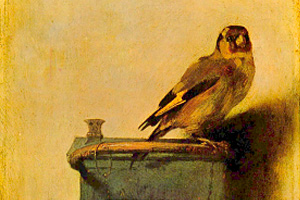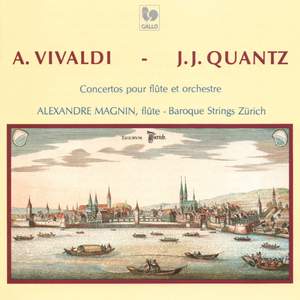By 1700, the concerto grosso had become the dominant instrumental genre. For certain composers of the younger generation, however, the concerto grosso had run its course and offered nothing to satisfy their compositional sensibility. Influenced by the great arias of the opera seria, composers like Giuseppe Torelli, Tomaso Albinoni and Antonio Vivaldi felt the need to make their instruments sing in a new way. Thus was born the solo concerto.

Under the creative genius of Antonio Vivaldi (1678-1741), who served as maestro di violino (1703) and then maestro dei concerti (1716), the orchestra of the Ospedale della Pietà of Venice became one of the most famous instrumental ensembles of all of Europe. Leaving nothing to chance, the governors of the Pietà ensured the continuous, high calibre training of the young wards of the institution. All instruments in current usage were integrated into the curriculum and ensemble.
Mac apps. Dear Twitpic Community - thank you for all the wonderful photos you have taken over the years. Windows 10 apps. We have now placed Twitpic in an archived state. In the Concerto for Flute in D Major, “Il gardellino” RV 428 Vivaldi demonstrates his perfect understanding of the instrument, writing trills, leaps, rapid florid passages, repeated notes, dotted rhythms, all of which evoke the warblings of a goldfinch.
As “Master of Concerts”, Vivaldi was required to compose a number of works for the orchestra. At the Pietà he was fortunate to have one of the best sounding boards for his musical creativity. The ensemble comprised accomplished musicians who had acquired a mastery of their instruments and Vivaldi used every opportunity to juxtapose or combine, in an almost painterly fashion, a variety of timbres and colours to create a multitude of musical effects.
In his compositions Vivaldi savoured the interchange between soloist and ensemble (tutti). He exploited contrast at both the formal and rhythmic level, favouring the fast-slow-fast movement structure. Vivaldi further pursued his predilection for opposition within individual movements composed in ritornello format, by constantly varying the accompaniment of the soloist (basso continuo, violins and violas, celli or solo keyboard, tutti).

Vivaldi breathed into his fast movements an outpouring of ideas and virtuosity never before heard. In his slow movements the composer drew inspiration from the operatic arioso, from dance forms (such as the sicilienne), from poetry, dream and melancholy.
Above all Vivaldi was lead by his own passionate temperament. Charles de Brosses who met Vivaldi during his journey to Italy in 1739-1740, described the composer in the following terms: “He is an old man (vecchio) who has a prodigious mania for composing. I have heard him boast of composing a concerto with all its parts more quickly than the copyist could write them down.” Indeed, did Vivaldi not compose his opera Tito Manlio in just five days? Not to mention more than 550 concertos!
Fierce passion was also demonstrated by Vivaldi the performer. On February 4th, 1715, J.J.A. von Uffenbach wrote in his journal: “He brought his fingers up to only a straw’s distance from the bridge, leaving no room for the bow — and that on all four strings with imitations [Fugen] and incredible speed.”

Vivaldi composed 39 concertos for bassoon, two of which are incomplete. After the violin, to which the composer dedicated some 230 concertos, the bassoon is the instrument for which he wrote the most concertos. His concertos for bassoon form part of an important musical collection preserved at the Biblioteca Nazionale di Torino (Turin) which comprises more than 450 works by Vivaldi — the majority autograph manuscripts.

That Vivaldi composed such a large number of concertos for the bassoon is surprising since by 1650 this instrument (or rather its ancestor the dulcian) had entered a long decline. Moreover the instrument had never been used in Venice as a solo instrument. The new bassoon was developed between the years 1660 and 1670 in the Paris workshops of the Hotteterre, and was also manufactured in Amsterdam and Nuremburg. By 1680 the bassoon had gained popularity across Europe but for some reason did not appear in Venice until much later.
For whom did Vivaldi compose his concertos? For Giuseppe (Gioseppino) Biancardi a bassoonist to whom the concerto RV 502 was dedicated? Unfortunately we know nothing about Biancardi other than that he was a member in 1727 of the Arte de’Sonadori (Guild of Instrumentalists) of Venice. For the court of Count Wenzel von Morzin, to whom he dedicated the concerto RV 496? (Count Morzin was also the dedicatee of the Opus 8, which contains The Four Seasons.) Or did Vivaldi compose his bassoon concertos for an instrumentalist at the Pietà? Despite the testimony of certain visitors who listed the bassoon among the instruments that they heard, the archives of the institution do not record a bassoon teacher, or the purchase of any instrument or reeds. While the debate continues one thing is clear, given their technical demands and the quality of the musical writing, Vivaldi’s bassoon concertos were written for an accomplished virtuoso.
While it is difficult to assign a precise date to the works it is generally assumed that the majority of the bassoon concertos were written between 1728 and 1737. The writing displays a profound understanding of the technical capacity of the instrument as well as its expressive potential which Vivaldi exploits in both the bass and tenor registers. In all of the concertos, Vivaldi does not hesitate to assign to the bassoon compositional idioms normally reserved for string instruments such as arpeggios, rapid scales, and register leaps.
Composed circa 1734-1735, the Concerto for Bassoon in A Minor RV 497 is a work characterized by contrast. Contrast is particularly evident in the Allegro molto where the violent accents of the ritornello are suddenly interrupted by a long silence (fermata) which momentarily gives way to a pianissimo passage played by the violins and violas before resuming its impetuous opening discourse.
More subdued, the Concerto for Bassoon in G Major RV 493 bears witness to the influence of the style galant. Two fast movements, in which the gaiety is tinged with a certain serenity, frame a hauntingly lyrical Largo.
Vivaldi Gardellino Imslp
Many consider the Concerto for Bassoon in E Minor (RV 484) to be one of Vivaldi’s most successful concertos. The opening Allegro poco draws inspiration from the only surviving movement of the Concerto for Flute RV 432. The Andante is languorous; the outer movements vigorous and intense, most notably the final Allegro with its irresistible and unmistakeable Vivaldian élan.
Jovial and exuberant, the Concerto for bassoon in B Flat Major is rich in melodic and rhythmic invention. The jewel of the concerto is the Largo with its ample orchestral introduction of two contrasting parts, which precedes the tender recitative-like chant of the bassoon. A brief tutti marked by detached notes create an unexpected effect and bring the movement to a sudden end.
Vivaldi composed approximately 15 concertos for flute, the most famous of which are the six concertos of Opus 10, published circa 1728 by Le Cène in Amsterdam. The Le Cène publication brings together works that likely constitute the first concertos written for transverse flute. According to music specialists the works were probably composed much earlier — possibly as early as 1710. The autograph manuscripts of eight of the nine other concertos for flute are preserved in Turin.

The baroque transverse flute, also developed in the Paris workshops of the Hotteterre, between 1670-1680, first appeared in Italy circa 1710-1720 and rapidly became a fashionable instrument. The flute first appeared at the Pietà following the pedagogical appointment of Ignazio Sieber, a talented oboist and flautist.
The first three concertos of Opus 10 are “programmatic” works which imitate picturesque elements of Nature: La tempesta di mar (The Sea Tempest) RV 433, La notte (Night) RV 439 and Il gardellino (The Goldfinch) RV 428.
In the Concerto for Flute in D Major, “Il gardellino” RV 428 Vivaldi demonstrates his perfect understanding of the instrument, writing trills, leaps, rapid florid passages, repeated notes, dotted rhythms, all of which evoke the warblings of a goldfinch. In the opening Allegro the first orchestral ritornello gives way to a solo flute passage a piacimento which provides the soloist an opportunity to indulge his musical imagination. The central Cantabile (a binary sicilienne) is pastoral in character. A second, lightly varied version of the concerto RV 428 exists in the form of a chamber concerto (the concerto di camera RV 90), likely written for the court of Mantua where Vivaldi stayed between 1718 and1720.
The manuscript of the Concerto for Flute in A Minor RV 440 preserved at Turin is not an autograph. In this work devoid of descriptive attribution, virtuostic acrobatics are abandoned in favor of a spare texture punctuated by several brilliant passages. Greater attention is given by the composer to the melodic line and expressivity giving the work a galant elegance. The concerto RV 440 dates from Vivaldi’s maturity and was likely composed in 1730.
Bearing the same title, La notte, the Concerto for Flute, op. 10, no.2 (RV 439) and the Concerto for Flute and Bassoon in G Minor RV 104 are musically related compositions. The presence of the bassoon gives the latter work its unique colour. Vivaldi depicts the theme of “the night”, tinged by supernatural fears, in seven short movements. In the guise of an overture the opening Largo is dominated by an obsessive dotted rhythm in the accompaniment and long disconcerting trills in the flute. Suddenly (Presto) ghosts (Fantasmi), represented musically by rising triplets, make their appearance. A short Largo subsequently leads to a brief, calming Andante. With a Presto interruption the ghosts reappear and the mood of agitation once again asserts itself (string tremolos). Sleep (Il sonno) arrives and is depicted by long note values. Dissonances, however, betray an agitated soul. Dawn follows and with it awakening (Allegro). The dream has run its course but the nightmarish visions of the night persist.
Vivaldi Il Gardellino Flute
The Concerto for Bassoon RV 501 also called La notte demonstrates the same dark program and formal plan as the concerto RV 439 but with a completely different musical content.
Vivaldi Il Gardellino Flute
Notes by Mario Lord, 2006 Translated by Ilene McKenna

Comments are closed.